Last-Minute NYC Holiday Gift Guide 🎁
We’ve created a holiday gift guide with presents for the intrepid New Yorker that should arrive just in time—


As a lifelong Lower East Sider, there are swaths of northern Manhattan that were once undiscovered to me, like the 35-acre City College of New York campus in Hamilton Heights. I had read that the college’s Gothic revival buildings were filled with gargoyles and grotesques that evoke a “Noo Yawk” version of Oxbridge, where even Harry Potter might feel at home. It was long on my New York bucket list.
Recently, Untapped Cities was offered a glimpse into many of the secrets of the Hamilton Heights campus, including forgotten tunnels and bell towers. On a simmering weekday evening in July when students were out of session, we were greeted by the 138th Street and Amsterdam Avenue gate by 25-year-old Dalton Whiteside, a cheery City College alum and enthusiast, in a straw hat and snappy outfit that suggested he was a time traveler from another century.
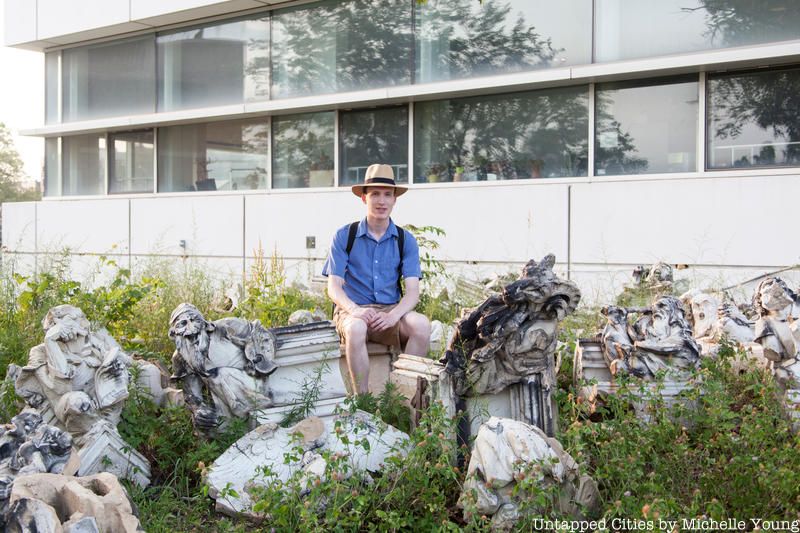
Dalton Whiteside, in the “gargoyle cemetery” of the City College of New York
Whiteside explained that the college was founded in 1847 as the Free Academy of the City of New York and renamed the College of the City of New York in 1866. Growing pains necessitated the institutional move uptown in 1906 after ground was broken in 1903.
Although there are 40,000 students when in session, City College was eerie as we walked on the empty campus in the heat. Whiteside did not check a single note as he spoke. He attended the college for architectural studies as an undergraduate, worked at the College archives for five years, and he dreams of publishing a book about the architecture of the campus and grounds.

Great Hall of Shepard Hall
After showing us some of the memorable gargoyles and grotesques and hitting us with a few cool factoids, Whiteside took us inside what is still the centerpiece of the campus, Shepard Hall. Among the secrets he revealed is that the original colorful pennants that hung in the magnificent Great Hall within this administrative building have been found in an attic – and (after cleaning and restoration) they will replace the gorgeous pennants that now hang there, lent by beloved Harlem artist Faith Ringgold, a cherished gift which will be moved to a new place of honor. Whiteside then took us outside of Shepard Hall, to see its cornerstone laid by Seth Low.
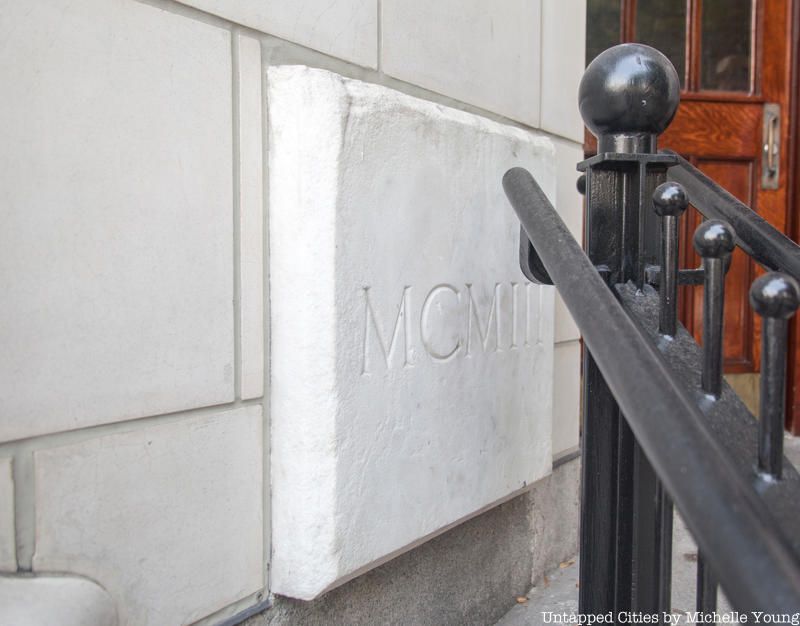
I knew Seth Low’s name from an imposing library building at Columbia University named to honor his presidency of the school, but in 1903 when he was invited to lay the cornerstone of the first building on City College’s campus, Low was mayor of a very recently (1898) consolidated New York City that included all five boroughs.
The cornerstone, which after all is just a rock with a Roman numeral carved into it, is unassuming and partially concealed behind a handrail. Whitestone directed our attention elsewhere, but I was still thinking about the cornerstone. An important city building, the cornerstone, a mayor — my time capsule radar went off.
Back in 2016, I happened upon two time capsules laid in Bloomingdale’s flagship department store by reading an article on the back of a brittle 1930 newspaper old scrapbook page I was using for research for my book, The Stowaway, about a forgotten Antarctica stowaway. My Untapped Cities article on their rediscovery and forgotten contents caught the attention of the sports section of the New York Times, mainly because not only was there a signed golf ball from Jazz Age superstar Bobby Jones in one of the capsules, there was also a signed Babe Ruth ball inside with perfect provenance. An expert I’d contacted had determined it would be the most valuable baseball in the world if recovered. Since then I’ve looked at every cornerstone with suspicion and hope. Who doesn’t want to get time capsule credit in the Times? That and a tap of my Apple Pay will get me on the subway, but it’s fun to let “I hunt time capsules” slip into cocktail party conversation.
In the tiny silent break as Whiteside walked us to our next site on campus I got him alone and whispered, “Dalton, do you know if there is a time capsule in that cornerstone?” He looked at me curiously. On the next break between campus marvels, he recalled seeing a drawing for a cavity within the cornerstone, but he didn’t know what might be in it.
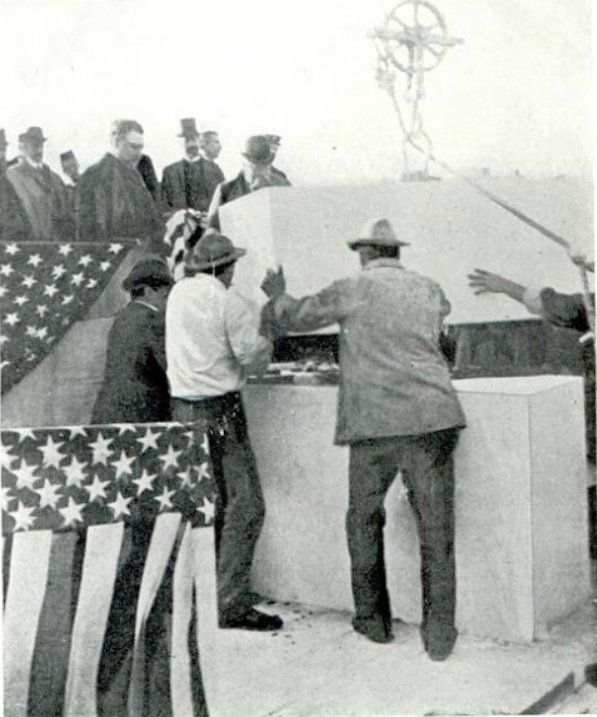
“Laying of the Cornerstone of New College,” photo in public domain from September 29, 1903 as seen in the publication “The Installation of John Huston Finley, LL.D., As President of the College of the City of New York at Carnegie Hall and the Laying of the Corner Stone of the New College Buildings, September Twenty-ninth, Nineteen Hundred and Three” from the City College of New York
That night I searched old papers I could access online from my home computer, including The Sun and the 16-page edition of the New York Times – both sold for a penny in 1903, the year the Stock Exchange was completed, and Enrico Caruso made his Metropolitan Opera debut in “Rigoletto.” I confirmed the time capsule was laid by the 92nd mayor on the Tuesday afternoon of September 29, 1903 at St. Nicholas Terrace and 140th Street by the administration building.
When the 63-year-old Low stepped forward after a formal introduction, he received a Tiffany-made silver ceremonial trowel engraved with his name for a memento. Low was a large guy, and a former college footballer. Then at 4:26 pm, Low dabbed the silver Tiffany trowel in cement and spread some mortar.
Somewhere online, I found that public domain picture of Mayor Seth Low that Whiteside had told me about, and I took out a magnifying glass. His once black wavy hair I had seen in in older photos had long turned gray, and in others from the same year he still he had the curly mustache of his youth. Yes, Whiteside was right, it did look like he was laying a box in the cornerstone moments before his job was done.
Okay, full disclosure, I *might* be known to get a little obsessive. Early the next morning I got a time capsule expert on the phone. Nicholas Yablon, an expatriate Londoner, and Associate Professor at the University of Iowa, and author of the just published book Remembrance of Things Present: The Invention of the Time Capsule and the Politics of Posterity (University of Chicago Press), explained to me that what I was describing in that old photo was more of a century box, and that the phrase “time capsule” didn’t really catch on until the 1930s. Prior to that, gifts to the future were called memorial chests, century vaults, or centennial safes.
“Cornerstone offerings before time capsules came into fashion were vague concepts, with no future target date those participating imagined they might be open,” he told me. “There was no sense [they were] directing them to recipients. I think of it as an antiquities deposit for the future, similar to blessing a building. These cornerstone offerings simply anticipated the coming loss of years, like blessings for a ship. Time capsules of later years were generally buried with a date to be opened. Although the 1930 time capsules you discovered in Bloomingdale’s cornerstone are curious examples. That rare cornerstone-time capsule to be opened.” The Golden Age of bona fide time capsules, he added, was around 1930-1950.
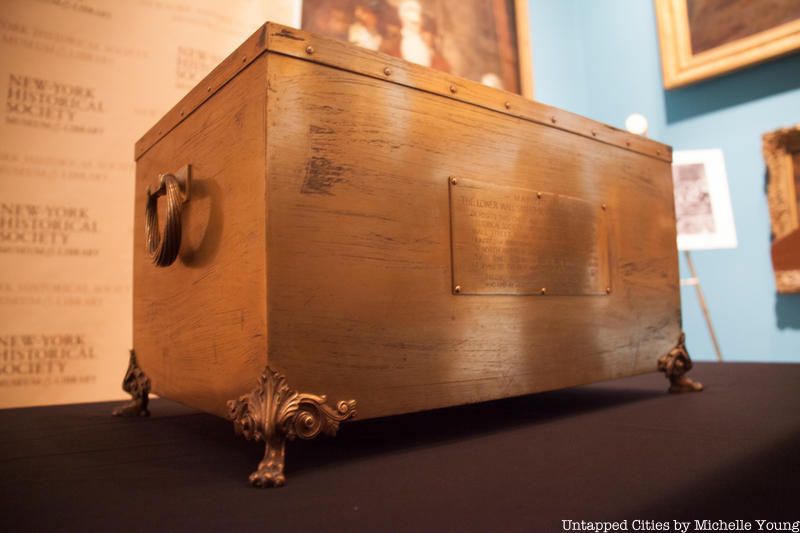
The time capsule at the New-York Historical Society, just prior to opening in 2014
Had Professor Yablon ever seen either a time capsule or century box opened? Twice. “At the New-York Historical Society when in 2014 they opened a time chest, and I saw a cornerstone box opened in California.” [Editor note: Untapped Cities was also there for the opening at the New-York Historical Society!]
Was he super excited?
Here he paused. “Excited? I’m an academic man.”
“And British,” I said.
“That is true. You can say the experience was—pleasant.”
The professor then hipped me to an older book by his mentor, Professor Neil Harris of the University of Chicago. Building Lives: Constructing Rites and Passages, published in 1999, does, as Professor Yablon promised, contain a very solid chapter on cornerstone history, if you want to dig deeper. (I’ll admit I got him on the phone, too.) I knew a lot more about time capsules than 24 hours earlier, but I still couldn’t find the contents of what I now knew was properly called a century box.
I headed to the main New York Public Library research library (with the lions) for those newspaper archives that might only be found by leaving my couch. Right away I learned the night and day leading up to the 1903 City College cornerstone ceremony were big events. On Monday night there had been a fancy banquet at the 12-story Savoy Hotel on Fifth Avenue at 59th Street where an astounding 70 presidents and other big shots of higher institutions cheered the new college president Dr. John Huston Finley on. (This strict Presbyterian would be the third president of the very secular institution, and serve from 1903-1913).
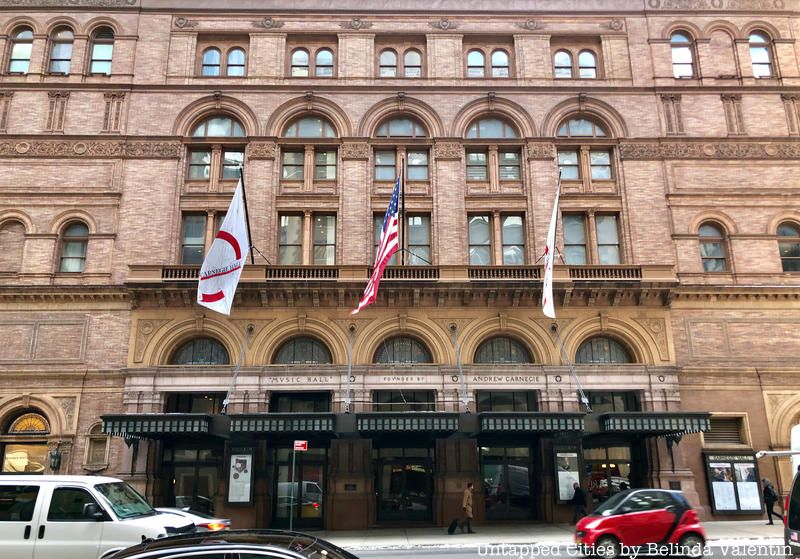
Carnegie Hall
Also sitting among the VIPs at the next morning event at Carnegie Hall, a building then only 11 years old, was our 22nd and 24th United States president, Grover Cleveland. The current and 26th president, Theodore Roosevelt, had dialed it in with a letter from his place in Oyster Bay, but his letter was read out loud and printed in its entirety in the papers.
Carnegie Hall was festively decorated with flags and college emblems, and the Greek pennants of the fraternities, while a significant portrait of George Washington was hung on the back stage in prominent view of all. The seven front rows were for juniors and seniors at the still downtown campus.
A luncheon was served and then most of the Carnegie Hall invited guests boogied uptown, boarding “a train of seven special street cars” to catch the next special event of the day. Mayor Low and his people were waiting for the arriving mob under a platform decked with colorful bunting built over the marble.
Princeton’s 39-year-old political studies professor Dr. Finley was being installed because City College’s president (and Gettysburg hero) General Alexander S. Webb had retired at president. That name—John Finley—popped out at me.
But from where?

I was soon reasonably sure there was a Manhattan promenade named after him that I’d walked as part of The Great Saunter, and annual event I’ve done twice that has thousands of fellow overly-enthusiastic New Yorkers walking the perimeter of Manhattan. I Googled. Okay, yes, it was along the western bank of the East River. Now in a walky mood, I immediately headed 5.5 miles from my Lower East Side block to East 85th Street at the East River. A stretch of Carl Schurz Park (home to Gracie Mansion) was named the John Finley Walk on July 1, 1941 to honor the peripatetic retired City College head who had walked the perimeter of Manhattan on his birthday for 30 years, and who liked to walk at least ten miles a day in the city, and who walked all over the world. As State Commissioner of Education for the State of New York, he walked from one town to the next, and in British-era Palestine he walked from Dan to Beersheba, an astounding 2726.9 miles.
Along the half-mile broad promenade there are two identical wrought signs of Finley tramping along with a walking staff and a scarf floating behind him with midcentury skyline and harbor view of Manhattan in the background. It was much more fun to see these signs in person than on the Wikipedia page I’d landed on. (One sign faces the river at 85th Street and its twin on 81st Street faces the cars on the FDR Drive).
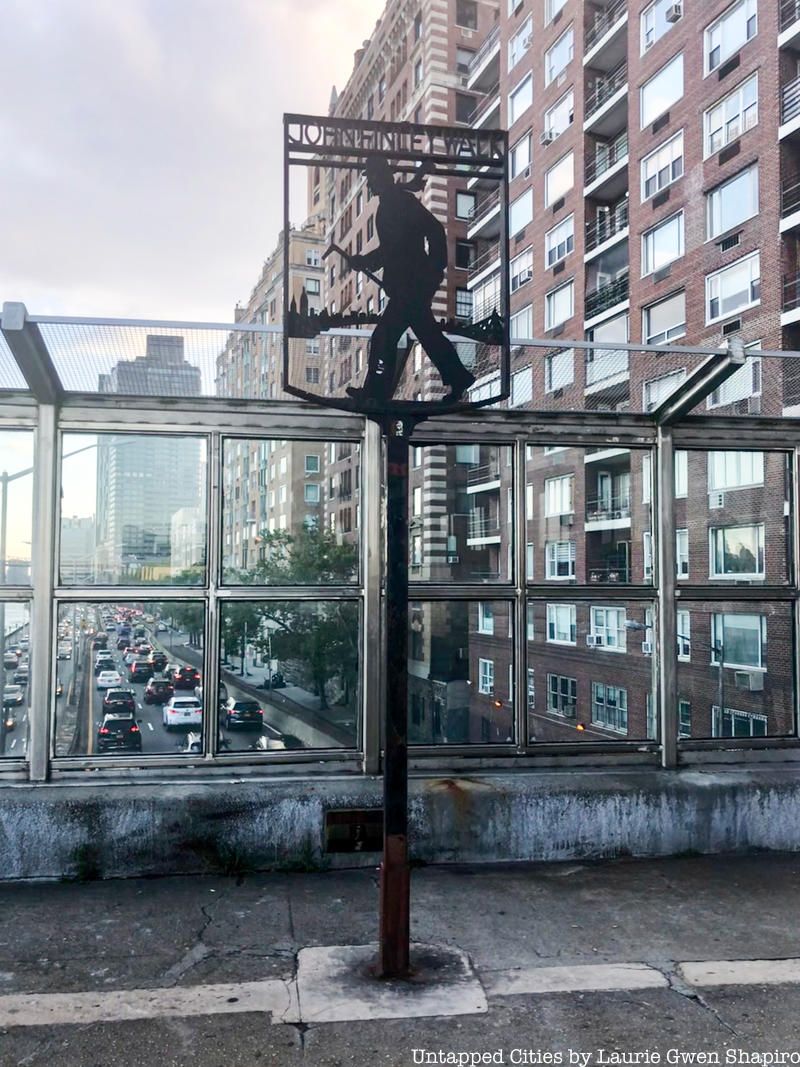
The signs were designed by Edwin Marcus, a once prominent New York Times cartoonist. Marcus knew Finley from the paper, when Finley was editor from 1937-1938 decades after his City College presidency. I don’t think of the Great Depression-era New York Mayor Fiorello La Guardia as arty, do you? But here is a factoid that made me happy – Mayor Fiorello LaGuardia was good pals with Finley too, and it was none other than Little Flower who suggested the motion in the plaques.
I then sat on a bench on the walkway and carefully reread the articles I’d copied at the library. And then, sitting right there on John Finley Walk, finally, I found a paragraph I’d missed with the 1903 cornerstone contents. But, damn!
Inside the metal box set in the stone were placed mere reports of the Committees of the Associate Alumni of the College of the City of New York, some miscellaneous papers, plus a history of the college, and the legislation. Likely there were also newspaper clippings, as I’d learned from Professor Yablon. Nothing enclosed in that cornerstone box was as sexy as a Babe Ruth ball. Again, like most century boxes, and unlike time capsules, this wasn’t expected to be opened.
Processing the less-than-exciting contents, I next wondered where this trowel no doubt inscribed to Seth Low was. A ceremonial trowel like the one Low used to spread mortar is a late 19th and early 20th century custom. Silver trowels inscribed with dignitary names are in the collection of both the Museum of the City of New York and the New-York Historical Society.
I obsessed on this for an hour, but I could not find it anywhere online and texted Whiteside, who pinged me back: “I learned that the 1903 trowel was offered for sale to City College in about 2003 for $12,000. Unfortunately, the college could not get the money together at that time. About 2013, I reached out to the dealer that had offered it for sale originally, and found that it had since been sold to a private collector. I hope that it can be returned to the college someday.” According to another old account I had photocopied at the library, Mayor Low watched carefully as the cornerstone was laid and he tapped it three times with the butt of the trowel.
Then Mayor Low (possibly secretly a Mason like many an American politician before him) said loudly for all to hear: “Mr. Architect, Mr. Chairman, Citizens of New York and Friends of this College, I pronounce the cornerstone of the College of the City of New York to be well and truly laid.”
(From what I gleaned in Freemasons for Dummies, during a cornerstone ceremony a stone is checked using ancient tools to be certain it is square, plumb (straight), and level, because a building constructed is not a good foundation. Next, the cornerstone is sanctified with corn (or grain), wine and oil – all of which are Masonic symbols of prosperity, health, and peace. Finally the stone is tapped into place with a gavel.)
There were cheers and applause after Low was good and done, especially from the students present who were dominating the northern part of the crowd.
Okay.
I’d finished up my research on the 1903 cornerstone, because c’mon, how much further could I go without blasting the stone open? But when compulsively checking any last hit on the internet, I saw mention of a second time capsule buried on the campus grounds in 1947, a real buried time capsule by Professor Yablon’s Golden Age of Time Capsule standards.
Wait, what?
Oh yes, Dalton Whiteside confirmed by email. Didn’t I tell you? He promised to disclose more at an upcoming meeting. His answer felt a little Bond. So after another large coffee I had another deep dive in New York history to see what I could find on my own. The cylindrical time capsule, I soon read, was 18-inches long, and 10 inches in diameter. (A Canadian paper erroneously said it was six feet long. Eh?)
This proper time capsule was conceived as part of the 100th anniversary of City College and designed by the chemistry engineering department (school of technology) under supervision of Dr. Charles Marlies. This cool thing was made of Monel metal, an expensive silvery-white alloy that is two-thirds nickel, and one-third copper with small amounts of iron, carbon, silicon, and manganese. According to old papers, it is meant to be dug up on Charter Day of the way future May 7, 2047, for CCNY’s bicentennial.
[You know I’m giving you a brief diversion on Monel, if this helps anyone from the way future reading: this forgotten alloy is a step up from stainless steel. It was first created in 1901 by the staff of World War vet Col. Ambrose Monell – the extremely wealthy president of the International Nickel Co (Inco), and named after the owner. (Family names were not allowed in trademarks at that time so one “l” was dropped.) Stronger than steel and more resistant to corrosion than bronze, was used in railroad dining car kitchens, where rust was a big issue, and it was also perfect for time capsules.]
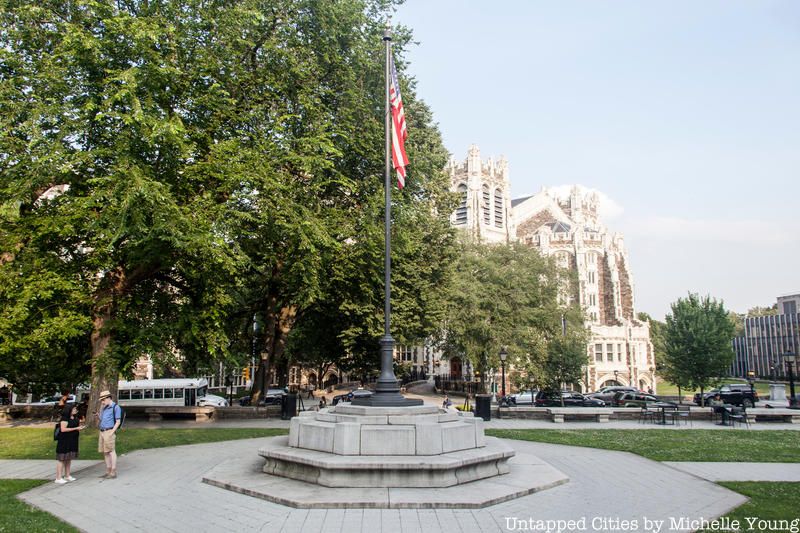
Back on May 1, 1947 the students from service fraternity Alpha Phi Omega had already started digging a six-foot hole at the Northwest corner of the flagpole. It was later lined with concrete.
The actual official-sinking-of-the-capsule event was listed on the school’s centennial Charter Day, May 7, 1947 for 2:45 pm. After all the pomp and ceremony, the capsule was buried around 3:15. Students wearing lavender and black centennial buttons cheered the moment. Also present were members of the class of 1897 who I suspect were hung over from their festivities the night before at The Fifth Avenue Hotel with their toastmaster, former Supreme Court Justice Peter B. Schmuck. (Long story longer, but I had to get this forgotten Schmuck in this story.)
57-year-old Mayor William O’Dwyer as there in 1947 too, and called the day, “A great one!” According to an anonymous student reporter (who would be around 90 years old if still alive), the burial was “televised” on both NBC and CBS.
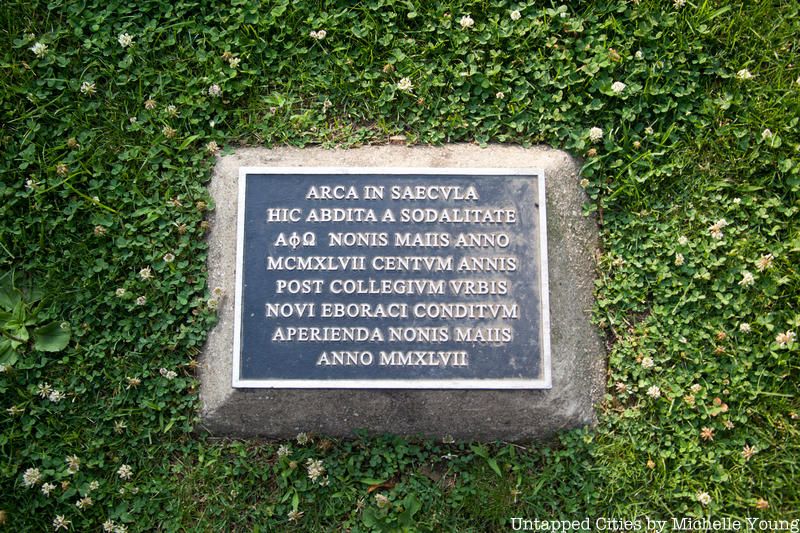
Combining mentions in various old sources I searched the next few days, here’s my list of what’s inside: centennial medals, one destined for the President of the United States in 2047, another for the president of CCNY, a third to go to the most outstanding member of the graduating class, and one for the most famous alumnus as chosen by a governing board; a documentary film about the college; a typed history of the college; four college publications including The Campus with, wisely, the very issue mentioning the time capsule, as well as the May 7 edition of the New York Times; a letter to the future from college president Dr. Harry N. Wright, pictures of students, faculty, alumni, and classes in session; part of the goalpost of the football win over Wagner College in 1946 (as their 27-6 win in fall of 1946 was their only victory in four years), a package of cough drops, and a hearty printed congratulations from their maker Smith Bros Inc, celebrating their cough drop centennial at the same time.
There was also a $50 bankbook fund to kickstart the bicentennial funding, a gift to the future the 1947 college economic department figured (compounded at a semi-annual rate) would yield $362 in 2047.
What does a modern statistician think? My dear and brainy high school friend Adam Shrager teaches high school statistics and is an adjunct professor at Princeton University, and previously helped me solve the worth of a bankbook found in the two Bloomingdale’s capsules.
Adam came to my rescue again. He explained to me the fundamental difficulty with this calculation is finding the historic savings account rates going back to 1947. “Not only is there not a central clearinghouse for them, but they vary A LOT by bank. Just today, for example, you can get savings account rates ranging from 2.9% to 0.1%. This matters a lot when compounded for one hundred years.”
Okay I grasped this.
Then, ruh roh, he went deeper into statistics-land. There were many many paragraphs of way over-my-head explanation before … “So I came up with $1252.56.” (For math types dying to know how he got there, check comments for the full explanation.)
Also in this 1947 time capsule is a 75-foot parchment scroll of signatures of 10,000 students who contributed one dollar each to the centennial fund for $1,500,000 war memorial building, collected again by those Alpha Phi Omega do-gooders.
One article said the capsule contains a jelly-like substance designed to remove moisture from the air so the items don’t decay. This bit of info was in an article sent to me by Whiteside. It had worried him since he read it, he told me by email. Did they mean coated with a jelly-like substance? Did the coating seep in and destroy the encapsulated documents?
To answer his apprehensions I contacted an inventor and scientist friend I met flying to London a few years ago on British Air, a Benjamin Gray, Doctor of Chemistry from Nottingham, England.
“If it was filled with goo, then possibly,” Dr. Gray told me. “But looking at that document scrap you offered me I wonder if it’s journalist interpretation of silica gel, a phrase which I imagine at the time wasn’t common. Silica gel in commonly used inside capsules, in the same way we get a sachet of it in just about every electronic item we purchase. I’ve searched various terms around a liquid, gel and silicon-based preservation for time capsules and the thing that comes up commonly is the addition of a desiccant bag inside the capsule. I’m pretty sure silica gel desiccant has been journalitized into jelly-like substance, which makes you think of documents in aspic.”
Whiteside also had a campus secret to show me when we finally met again: Three years after the City College centennial time capsule was buried, a bronze plaque was placed in the ground on May 4, 1950. It wore out, and was replaced, and wore out again. It was most recently replaced for a third time by Whiteside back when he was an undergraduate. (I did say he was a City College enthusiast!)
ARCA IN SAECVLA HIC ABDITA A SODALITATE ALPHA PHI OMEGA. NONIS MAIIS ANNO MCMXLVII CENTVM ANNIS POST COLLEGIVM VRBIS NOVI EBORACI CONDITVM APERIENDA NONIS MAIIS ANNO MMXLVII
Whatever high school Latin I gleaned from Dr. Jamo Blake is long gone, and frankly Google Translate gave me garbled results. Fortunately a Latin teacher named Molly LaPorte gave me a better translation for this article.
A box for the ages buried by the Alpha Phi Omega fraternity
On May 7th, 1947
One hundred years after the founding of the College of New York
To be opened on May 7th, 2047
It is unlikely Dalton Whiteside or I will ever see the inside of the 1903 cornerstone and we won’t be spring chickens if we live to see the 2047 opening of the 1947 time capsule, but we made a date to meet again on the site in 2047. How fun that will be!
But then just as I was headed for the subway Whiteside said, “Do you know there is a third time capsule here? Do you want to see it?” (Of course I did.) I followed him to Lewisohn Plaza on the north campus. Items commemorating life at The City College of New York were buried in a time capsule here on Adolph Lewisohn Plaza of Honor on November 17, 2000; and this third capsule is to be opened in the year 2050. (The open-air plaza stands where the once iconic Lewisohn stadium was demolished.)

No matter how hard I searched that night, I couldn’t find the contents, and even Whiteside has never seen a list of the contents. This is pretty recent history. Were any readers there? Might you update us?

Wow. Three time capsules! Or one century box and two time capsules, for purists like Professor Yablon. You would think that would be it!
Yet looking for any last mentions back at the lions library as I was finishing this piece, I read about a fourth time “capsule” found in the stadium’s cornerstone during demolition. (The 1970s reporter called it a time capsule, but we know it is a century box.)
Oh no.
Another hour later, I determined it contained copies of the Times, the Herald, the Tribune, and the Sun from the date of the stadium’s dedication on June 15, 1914.
Unlike the 1903 cornerstone pomp, this fourth ceremony was a casual affair and attended only by a few dignitaries and students. Remember superwalker and former City College president John H. Finley? By then Finley was the State Commissioner of Education, and with his wife Martha Ford Boyd Finley, laid the cornerstone box on the corner of Amsterdam Avenue and 136th Street. In Masonic tradition, John and Martha Finley tapped three times with the trowel after the granite block was laid.
This fourth offering (discovered by a demolition crew in 1973) contained the architect’s plan for the stadium, several unidentifiable photos, a quarter minted in 1914, and papers related to the stadium’s construction. Old papers say there were several coins inside. The 1914 quarter was presented to then President Robert E. Marshak, a former scientific prodigy and fellow who helped develop the Atomic bomb, and the rest turned over to archives. 1970s City College librarian Allen Streit of City College’s archival department was quoted in the student paper that what was found had not been preserved well and were badly deteriorated.
I think that’s all the century boxes and time capsules of City College of New York. Or should I say I hope that’s all! My great expectation is that the bigger architectural history of City College is in fine hands with young Dalton Whiteside, and that he will keep up the good historic fight and finish his book. I’m also eager to make an appointment soon with the CCNY archives to see what survived from this fourth offering, but I’m a little afraid there will be another vintage surprise before I file this story. There are, after all, an awful lot of old buildings on campus with “untapped” histories.
Next, check out our story about the hidden time capsules inside Bloomingdale’s.
Subscribe to our newsletter